Por favor, use este identificador para citar o enlazar a este item:
http://hdl.handle.net/10261/218002COMPARTIR / EXPORTAR:
 SHARE SHARE
 CORE
BASE CORE
BASE
|
|
| Visualizar otros formatos: MARC | Dublin Core | RDF | ORE | MODS | METS | DIDL | DATACITE | |

| Título: | The life of behavior |
Autor: | Gomez-Marin, Alex CSIC ORCID; Ghazanfar, Asif A. | Fecha de publicación: | 2019 | Editor: | Elsevier | Citación: | Neuron 104(1): 25-36 (2019) | Resumen: | Neuroscience needs behavior. However, it is daunting to render the behavior of organisms intelligible without suppressing most, if not all, references to life. When animals are treated as passive stimulus-response, disembodied and identical machines, the life of behavior perishes. Here, we distill three biological principles (materiality, agency, and historicity), spell out their consequences for the study of animal behavior, and illustrate them with various examples from the literature. We propose to put behavior back into context, with the brain in a species-typical body and with the animal’s body situated in the world; stamp Newtonian time with nested ontogenetic and phylogenetic processes that give rise to individuals with their own histories; and supplement linear cause-and-effect chains and information processing with circular loops of purpose and meaning. We believe that conceiving behavior in these ways is imperative for neuroscience. | Versión del editor: | https://doi.org/10.1016/j.neuron.2019.09.017 | URI: | http://hdl.handle.net/10261/218002 | DOI: | 10.1016/j.neuron.2019.09.017 | ISSN: | 0896-6273 | E-ISSN: | 1097-4199 |
| Aparece en las colecciones: | (IN) Artículos |
Ficheros en este ítem:
| Fichero | Descripción | Tamaño | Formato | |
|---|---|---|---|---|
| accesoRestringido.pdf | 59,24 kB | Adobe PDF |  Visualizar/Abrir |
CORE Recommender
PubMed Central
Citations
46
checked on 11-abr-2024
SCOPUSTM
Citations
73
checked on 15-abr-2024
WEB OF SCIENCETM
Citations
68
checked on 26-feb-2024
Page view(s)
62
checked on 18-abr-2024
Download(s)
15
checked on 18-abr-2024
Google ScholarTM
Check
Altmetric
Altmetric
Artículos relacionados:
NOTA: Los ítems de Digital.CSIC están protegidos por copyright, con todos los derechos reservados, a menos que se indique lo contrario.
